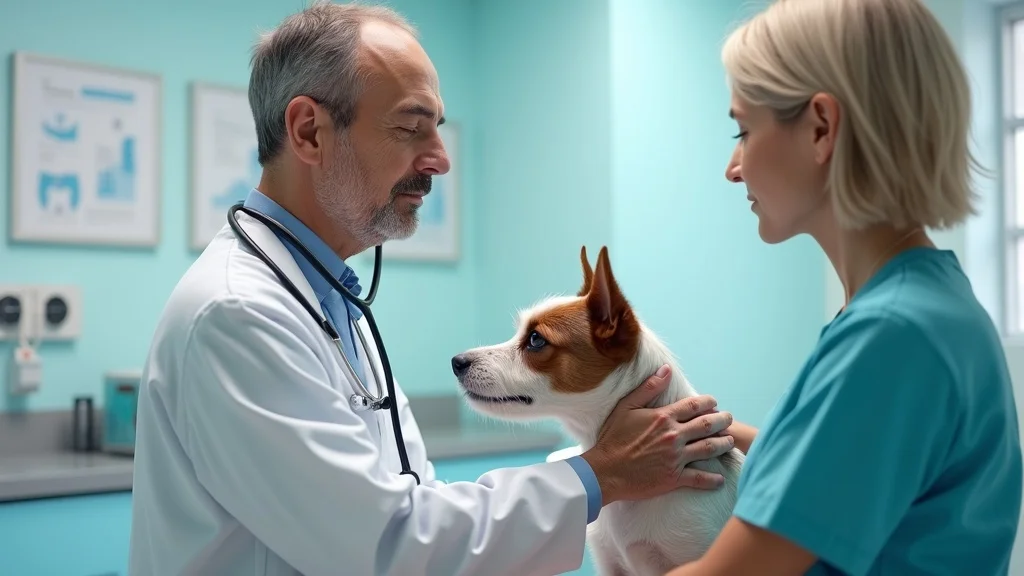Could your dog’s subtle changes be hiding a bigger problem? Uncover the key signs of illness in your furry friend so you can act fast, protect their health, and be the pet parent your dog deserves.
Could Your Dog’s Subtle Behavior Changes Mean More Than You Think? Understanding What Are the Signs My Dog Is Sick
Have you ever noticed your dog acting a little different—maybe sleeping more, ignoring their food, or just not as playful as usual? What are the signs my dog is sick is a crucial question for every pet owner. Sometimes, the smallest shifts in behavior can mean a lot more beneath the surface. Dogs are experts at hiding discomfort, so those gentle changes in energy or eating might signal an underlying health issue. Knowing what the common signs are, like weight loss, loss of appetite, or sudden behavior swings, means you can recognize something’s off before it turns serious. Acting quickly when your dog is sick can make all the difference for their recovery. As pet parents, learning to spot these early red flags ensures you get your pup the care they need right away—before a minor sickness becomes a major concern.
In this comprehensive guide, we’ll break down everything you need to know about the signs your dog is sick, from the most subtle but important clues to when it’s time to rush to the animal hospital. You’ll get easy-to-follow advice backed by veterinary insights, clear steps for monitoring your dog’s health, and practical tips for caring for sick dogs—especially if you have a senior dog at home. By the end, you’ll feel more confident reading your dog’s signals and knowing when to seek help from your veterinary hospital. Stay tuned for the early warning signs every pet owner should recognize—because your dog depends on you to notice when things aren’t right!
What You’ll Learn About Early Signs Your Dog Is Sick
- Key behavioral and physical changes indicating your dog is sick
- How to spot weight loss and loss of appetite in your dog
- Guidance on when to contact an animal hospital or veterinary hospital
- What the most common sicknesses in dogs look like
- Tips for monitoring senior dogs and their health signs
Why Recognizing What Are the Signs My Dog Is Sick Matters for Your Pet’s Health
Early intervention saves lives. Spotting the signs your dog is sick allows you to catch problems before they escalate. Dogs communicate through behavior, subtle shifts, and physical cues—so as a pet owner, observing your furry friend closely can make all the difference. Acting quickly can often mean a faster, easier recovery and even prevent long-term complications or costly treatments. And for senior dogs or puppies, monitoring health signs is even more critical since their systems can change rapidly and they might not bounce back as quickly as adult dogs. Understanding what are the signs my dog is sick empowers you to protect your best friend and give them the healthiest, happiest life possible.
"Catching the subtle signs your dog is sick early can mean the difference between a quick recovery and long-term complications." — Dr. Michelle Banner, DVM
Most Common Signs Your Dog Is Sick: What Every Owner Should Watch For
Every pet parent should be familiar with the common signs that may point to a sick dog. Dogs cannot explain how they’re feeling, so being attentive to tell-tale signals is crucial. From loss of appetite and weight loss to symptoms like vomiting or diarrhea, and changes in breathing or activity level—these are clear alerts that something is wrong. Sometimes, these signs are mild at first; for example, a dog might just seem a bit tired or less interested in play, but over time, these can indicate underlying health problems. If you notice your dog exhibiting any combination of these symptoms, it’s wise to call your vet or consider a veterinary hospital visit to avoid worsening issues.
- Loss of appetite
- Unexplained weight loss
- Lethargy and decreased activity
- Vomiting or diarrhea
- Coughing or sneezing
- Difficulty breathing
- Unusual behaviors or aggression
- Excessive drinking or urination

Physical and Behavioral Symptoms: What Are the Signs My Dog Is Sick?
Physical symptoms are often the first cues a pet owner will notice when a dog is sick. Signs like loss of appetite, vomiting or diarrhea, weight loss, lethargy, and changes in breathing can all point to a serious underlying health issue. On the behavioral side, your dog might seem withdrawn, unusually clingy, or display increased aggression. Recognizing these changes immediately is key; in many cases, earlier veterinary intervention results in better outcomes. Monitoring food and water intake, energy levels, and social behavior enables you to spot problems as soon as they arise and take appropriate action.
Be especially observant in senior dogs. As they age, dogs may face more health problems like kidney disease or arthritis, and changes may be more gradual. Subtle shifts such as increased thirst, frequent urination, or reduced mobility are often overlooked yet are common signs your dog is sick. Always compare your dog’s current habits to their normal routines, and don’t hesitate to consult your vet about any unusual or new behaviors.
Loss of Appetite and Its Link to Common Dog Illnesses
Loss of appetite is one of the most common signs your dog is sick and should never be ignored. While dogs may skip a meal now and then due to stress or mild stomach upset, continuous refusal to eat may signal something more severe. Health issues like dental disease, infections, kidney disease, or gastrointestinal problems can make food unappealing or painful. If your dog’s lack of appetite is accompanied by vomiting, lethargy, or rapid weight loss, it’s time to schedule an appointment with your vet immediately. Catching this symptom early helps ensure proper treatment and prevents dangerous drops in energy or nutrition. Pet owners should note if their dog also seems disinterested in treats or water bowl visits, as this suggests a more systemic issue that needs prompt veterinary attention.
Pet parents should keep a log of their furry friend’s eating patterns. Even a subtle or gradual change in appetite or feeding habits can be one of the first signals that a dog is sick, especially for senior dogs, who are more vulnerable to underlying disease. Remember, always err on the side of caution—if you notice a sudden change, call your vet for guidance on what to do next.
Weight Loss: When a Dog Is Sick and What This Could Indicate
Unexplained weight loss in dogs is a worrisome sign and can indicate everything from dental disease and intestinal parasites to chronic conditions like diabetes or kidney disease. Unlike humans, dogs don’t typically shed pounds without a reason. If you notice your dog losing weight despite eating normal amounts of food—or if combined with other symptoms like lethargy or excessive thirst—this may point to a serious health issue. Sudden or gradual weight loss in a senior dog should always prompt a visit to the veterinary hospital for a full evaluation.
Other pet owners have found that tracking their pet’s weight over time is a helpful way to catch changes early. Get in the habit of weighing your dog every few weeks or at each grooming visit, especially if they’re older or have a history of health problems. Early detection and intervention are crucial to preventing complications and ensuring your pet gets back to their healthy self.
"Sudden weight loss in dogs is never normal and warrants a veterinary hospital visit." — Dr. Laura Evans, Veterinary Surgeon
Vomiting or Diarrhea: Red Flags That a Dog Is Sick
While an occasional mild stomach upset can happen, frequent vomiting or diarrhea is a strong indicator of a sick dog. These symptoms may be caused by dietary indiscretion, infections, toxins, or more serious underlying problems like kidney disease, gastrointestinal disease, or pancreatitis. If vomiting or diarrhea persists for more than 24 hours, includes blood, or is accompanied by lethargy, fever, or rapid weight loss, seek veterinary care right away. Dehydration can become life-threatening in dogs quickly, especially in puppies and senior dogs, making prompt attention a must.
Pay attention if your dog avoids eating, seems reluctant to drink water, or acts distressed after vomiting. Keep track of frequency, volume, and appearance of sickness for your vet, as this information can help diagnose the underlying cause faster. Never ignore these symptoms, as early veterinary intervention can dramatically improve outcomes and reduce recovery time.

Difficulty Breathing, Coughing, or Sneezing — Respiratory Warning Signs
Difficulty breathing, persistent coughing or sneezing are important warning signals that your dog is sick and may have a respiratory infection or heart condition. These symptoms can stem from simple irritants like dust or pollen, but can also be signs of pneumonia, kennel cough, or even heart failure—conditions that require prompt medical treatment. Watch for rapid, shallow breaths, gagging, noisy breathing, or blue-tinged gums/tongue. These indicate an emergency and mean you should contact your veterinary hospital or rush to an animal hospital immediately.
Puppies, senior dogs, or breeds with flat faces (like pugs or bulldogs) are more prone to respiratory distress. Pet owners should pay close attention to how their dogs breathe during rest and exercise, and note any changes in stamina or breathing sounds. Coughing, sneezing, or labored breathing that lasts longer than a couple of days—or worsens quickly—should always be taken seriously for your dog’s safety.
Lethargy, Weakness, and Reduced Activity in Sick Dogs
Is your dog sleeping more, reluctant to get up, or less interested in activities they once loved? Lethargy or weakness is a common sign your dog is sick and may signal anything from a mild infection to a more serious health problem like internal bleeding or endocrine disorders. Especially for senior dogs, a decline in energy should never be dismissed as “just old age”—it’s a potential clue something more is going on. Lethargy, when paired with other symptoms like appetite loss, vomiting, or rapid weight loss, points to a need for prompt veterinary evaluation.
Make a habit of tracking your dog’s typical daily routine, so you can easily spot sudden changes in sleep, play, or social behavior. Most pet owners find this helps them catch health issues early. Don’t hesitate to call your vet if you see persistent or worsening fatigue—your intervention could save your furry friend’s life.

Behavioral Shifts: How Senior Dog Health Signs Differ
Senior dogs often show different symptoms when they are sick compared to younger dogs. Changes in behavior—such as increased withdrawal, confusion, or uncharacteristic aggression—are sometimes the only early clues to a health problem. Because aging dogs are more prone to chronic illnesses like arthritis, kidney disease, or cognitive dysfunction, pet owners must stay vigilant for even subtle mood or routine changes. A senior dog that becomes less social, seems depressed, or suddenly starts having accidents indoors may be suffering from a treatable illness.
Remember: as your dog gets older, their tolerance for dehydration, infection, or pain decreases. Monitoring them closely and building a relationship with your veterinarian are key steps in keeping your senior dog comfortable and healthy for as long as possible.
Unusual Aggression or Withdrawal in Senior Dogs
Senior dogs who are sick often display behavior that’s out of character—such as sudden aggression toward family members, withdrawal, or a desire to be left alone. This may be a sign of pain, confusion, or the discomfort that comes from chronic illnesses like arthritis or organ disease. Some senior dogs become irritable, while others seek isolation, even if they were previously social. For pet parents, these behavioral shifts serve as early warning signs of serious health issues that require attention and veterinary guidance.
If your senior dog growls, snaps, hides, or seems bothered by gentle petting, consider having them evaluated for pain or underlying conditions. Pain management, dietary adjustments, or medication for cognitive dysfunction can often restore their quality of life. Do not ignore personality changes; they are often the best clues that your aging furry friend needs help.

Common Signs of Kidney Disease and Chronic Illness in Senior Dogs
Kidney disease is a leading chronic illness in senior dogs and often develops gradually, making early detection a challenge. Some common signs include increased thirst, frequent urination, loss of appetite, weight loss, halitosis (bad breath), and overall decline in energy. Because these symptoms are nonspecific, many pet owners don’t recognize them as kidney disease until the condition has progressed. It’s important to get regular bloodwork for senior dogs, especially if you notice any changes in drinking, eating, or urination patterns.
Other chronic illnesses in older pets, like diabetes or thyroid disease, can also present as subtle changes in routine or grooming. If your senior dog is drinking more water than usual or showing a decrease in body weight and muscle mass, contact your vet promptly for a checkup and consultation about possible chronic health issues. Managing kidney disease and similar illnesses early can greatly improve comfort and lifespan.
Monitoring Hydration and Urination Patterns in Older Dogs
One of the clearest indicators of sickness in senior dogs is a sudden change in water intake and urination frequency. Drinking more water than usual, house-soiling, or difficulty urinating can all be signs of kidney disease, diabetes, or urinary tract infection. Leaving extra bowls of water around the house for your older dog and observing how often they visit the water bowl are simple ways to spot a problem.
Keep an eye out for blood in the urine, strong-smelling or cloudy urine, or signs of discomfort while peeing. These should trigger an immediate call to your vet, as early treatment is essential for your dog’s health. In older pets, even mild dehydration can turn serious quickly—regularly topping off water bowls and recording bathroom habits helps pet owners respond right away.

When to Take Action: Visiting an Animal Hospital or Veterinary Hospital
Knowing when to act can be the difference between a small scare and a health emergency. If you notice sudden changes in your dog's appetite, behavior, breathing, or bathroom habits, don’t wait to see if things improve—call your vet or visit an animal hospital right away. Persistent vomiting or diarrhea, difficulty breathing, unresponsiveness, bloody urine/stool, or a swollen, painful belly are all alarms. Always bring a list of symptoms to your appointment, along with any notes about food, water, and medication history. This gives your veterinary hospital team a clear starting point for assessment and care. Below are steps to consider for pet parents:
- Signs Your Dog Needs Immediate Medical Attention: Difficulty breathing, collapse, seizures, repeated vomiting/diarrhea, uncontrolled bleeding, or sudden severe lethargy.
- Preparing for Your Veterinary Hospital Visit: Bring details about recent behavior, food and water intake, any medications or supplements, and a description of all symptoms.
- Questions to Ask Your Veterinarian: What could be causing these symptoms? What diagnostic tests are needed? What is the treatment plan and at-home care?
Preventing Illness: Essential Pet Care Practices for Dog Owners
Prevention is always easier than treatment. Keeping your dog healthy involves a simple routine: annual checkups, staying on track with vaccinations, and keeping up with parasite control and dental hygiene. Watch for changes in appetite, weight, and hydration, and don’t overlook bad breath or new odors—they could point to health issues like dental disease.
- Routine check-ups
- Vaccination and parasite control
- Weight management
- Dental hygiene
- Hydration monitoring

Understanding the Most Common Sickness in Dogs: A Closer Look
The most common sicknesses in dogs can vary by age and environment, but they all share key warning signs. Here’s a quick overview of what to watch for and when it’s time to contact your vet:
| Sickness | Symptoms | When to See a Vet |
|---|---|---|
| Gastroenteritis | Vomiting, Diarrhea | After 24 hours of symptoms |
| Kidney Disease | Increased thirst, urination, lethargy | Immediately |
| Respiratory Infections | Coughing, Sneezing, Nasal discharge | Persistent >2 days |
| Arthritis (Senior Dogs) | Limping, Reduced mobility | Upon notice |
People Also Ask: How Do I Tell If My Dog Isn't Feeling Well?
Noticing Early Changes When Asking What Are the Signs My Dog Is Sick
Noticing that your dog isn’t feeling well starts with observing small shifts in their daily habits. A normally enthusiastic dog who seems withdrawn, avoids meals, or is unwilling to play may be experiencing a health issue. Keep an eye out for decreased appetite, sudden changes in energy, persistent sniffles or coughing, or skipping bathroom breaks. The earlier you catch these signs your dog is sick, the sooner your furry friend can get the help they need. When in doubt, it’s always better to reach out to your vet than to wait and see.
People Also Ask: How Do Dogs Act When They Are Sick?
Behavioral Patterns and Physical Symptoms When a Dog Is Sick
When a dog is sick, their actions often tell the story first. You may notice them sleeping more than usual, shying away from attention, or even showing signs of confusion. Some sick dogs become clingy or anxious, while others isolate themselves. Physical symptoms like vomiting, diarrhea, coughing, sneezing, or difficulty breathing may also appear. If your dog is off their normal routine, not interested in food, or just “not themselves,” trust your instincts and consult your veterinarian. These behavioral and physical cues are your dog’s way of asking for help.
People Also Ask: What Are Four General Symptoms That a Sick Animal Will Have?
Key Universal Signs to Remember When Spotting a Sick Dog
There are a few universal signs that a sick dog—or any animal—will often show:
- Loss of appetite or rapid decrease in food intake
- Lethargy or lack of normal activity
- Changes in urination or defecation patterns (including vomiting or diarrhea)
- Difficulty breathing, coughing, or sneezing
Any combination of these general symptoms should prompt you to call your vet for more guidance. Acting quickly ensures your pet gets the care they need.
People Also Ask: What Is the Most Common Sickness in Dogs?
Overview of Prevalent Diseases Every Dog Owner Should Know
The most common sickness in dogs varies, but some cause more visits to the vet than others. Gastrointestinal issues like gastroenteritis (vomiting and diarrhea), skin infections, urinary tract infections, respiratory diseases, and dental problems top the list. Senior dogs are especially vulnerable to chronic conditions like arthritis and kidney disease—watch for weight loss, stiffness, increased thirst, or changes in urination patterns. By understanding these prevalent diseases and their symptoms, pet parents can keep their furry friends healthier and happier.
Frequently Asked Questions: What Are the Signs My Dog Is Sick?
-
Q: How can I tell if my dog is just tired or actually sick?
A: If tiredness is accompanied by other symptoms—loss of appetite, vomiting, diarrhea, or sudden behavior changes—it’s likely more than just fatigue. Monitor closely and contact your vet if symptoms persist. -
Q: What should I do if my dog refuses to eat or drink for more than a day?
A: Loss of appetite for over 24 hours is a red flag. Call your veterinarian, especially if you notice other symptoms like vomiting, lethargy, or weight loss. -
Q: Can stress cause my dog to get sick?
A: Yes, stress can suppress a dog’s immune system, making them more vulnerable to illness. Chronic stress or anxiety can manifest as appetite changes, digestive upset, or behavioral shifts. -
Q: Is vomiting in dogs always an emergency?
A: Occasional, isolated vomiting is not always urgent, but if it’s recurrent, severe, or accompanied by other symptoms, seek veterinary care immediately. -
Q: How often should I bring my healthy dog for a vet exam?
A: Adult dogs should see a vet at least once a year for checkups, while puppies and senior dogs may need more frequent visits.
Key Takeaways for Spotting If Your Dog Is Sick
Act quickly, watch for changes, and trust your instincts. Knowing the early signs your dog is sick can help you intervene before a simple problem becomes a bigger health issue.
Stay Informed – Subscribe for More Pet Health Articles
Want more tips, stories, and pet care guides delivered straight to your inbox? Join our monthly PawPress newsletter and stay in the loop with the latest for your furry friends. 🐾 Subscribe now — your pets will thank you!
Recognizing the early signs of illness in your dog is crucial for timely intervention and effective treatment. To deepen your understanding, consider exploring the following resources:
-
“How to Tell If Your Dog Is Sick: Recognize Symptoms” (petscare.com)
-
“11 Signs Your Dog May Be Sick” (healthcarter.com)
These articles provide comprehensive insights into the behavioral and physical indicators of canine illness, equipping you with the knowledge to act promptly when your dog’s health is at risk.
 Add Row
Add Row  Add
Add 




Write A Comment